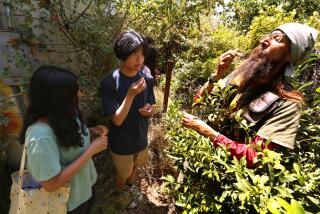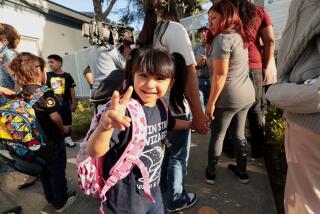Bilingual Charter School Hopes to Be a Model, in Any Language
- Share via
Standing only about a yard high himself, Anthony Gutierrez mustered all his strength to extend a wooden yardstick over his head.
With his back to his fellow kindergartners, Anthony perched on his tiptoes and pointed at the alphabet spelled out above him.
For the record:
12:00 a.m. April 11, 2002 FOR THE RECORD
Los Angeles Times Thursday April 11, 2002 Home Edition Main News Part A Page 2 A2 Desk 2 inches; 52 words Type of Material: Correction
Bilingual charter school--A story and caption in Tuesday’s California section about the Multicultural Learning Center in Canoga Park may have implied incorrectly that it is the first in the Los Angeles Unified School District to offer a dual-language curriculum. It’s the first charter school to do so. A second dual-language charter school is planned in Boyle Heights.
Instead of the A for apple or Z for zebra, in this alphabet, A stood for el arbol (tree) and Z for los zapatos (shoes).
This was a typical morning lesson at the Multicultural Learning Center, a dual-language charter elementary school in Canoga Park with a simple mission: Every student, regardless of native language, will speak both English and Spanish fluently by the fifth grade.
Of the 791 schools in the Los Angeles Unified School District, the Multicultural Learning Center is the first that offers a dual-language curriculum. A second, in Boyle Heights, is in the planning stages. The center also is one of only 15 dual-language public charter schools in the state, according to the California Network of Educational Charters, a charter school advocacy group.
The Spanish-immersion method might seem controversial in a state where voters in 1998 chose essentially to eliminate bilingual education in public schools. But, as a charter school, the Multicultural Learning Center receives federal, state and local funds and is free to hire its own faculty and establish its own curriculum. It does not have to adhere to the same policies other district schools must follow. The state Department of Education Charter Schools Unit oversees California charter schools.
Supporters say they are convinced the approach will work. Within a few years, the center hopes to be a strong example of good dual-language instruction--and good schooling overall, says a district official.
“We have hopes that they will eventually become a model for those schools interested in dual-language instruction,” said Grace Arnold, who supervises 39 charter schools in the Los Angeles district.
Three years ago, Tobey Bornstein came up with the idea for the Multicultural Learning Center. Bornstein, who had spent more than 35 years as an educator, said the concept sprang out of a deep-seated faith in both charter schools and bilingualism.
Research, including some funded by the U.S. Department of Education, has shown “that children whose first language is Spanish do much better in English when they develop language abilities in Spanish first,” said Bornstein, the center’s executive director.
And while it’s true that native English speakers might fall a little behind in English literacy at first, she said, by the fifth grade they will have more than caught up--and will be fluent in a second language.
These arguments won over L.A. Unified in April 2001, when the district granted a small group of San Fernando Valley educators, business people and community leaders a charter for the school.
In September, the school opened with 194 students in kindergarten through fourth grade in space rented at the Faith Lutheran Church on De Soto Avenue. There, 11 bilingual teachers lead classes with 20 to 25 students each. Fifth grade will be added in the fall.
Now in their second semester, the students seem to be catching on.
Five-year-old Paige Nelson, whose family speaks English at home, finds reading in Spanish easier, said her mother, Sheri Nelson.
“For a kindergartner to read at all is amazing,” Nelson said. “And my daughter is reading in Spanish.”
In kindergarten and first grade at the school, students are immersed in Spanish-only instruction about 90% of the day.
By fifth grade, students will spend half their day learning in Spanish and half in English.
Four years ago, California voters effectively eliminated bilingual education when they approved Proposition 227. Generally, the law requires all California students be taught in English.
Bilingual programs would be made available only if parents apply for waivers at their children’s schools.
Some supporters of the proposition say the center seems to be skirting the law.
“The long-fought battles leading up to Prop. 227 and the ensuing courtroom battles have all resulted in a commitment to English immersion,” said David Gersten, executive director of the Center for Equal Opportunity, a Washington, D.C.-based conservative think tank that works to eliminate race considerations from employment and schooling.
Bornstein said the center makes practical sense, especially in her Canoga Park neighborhood where 44% of residents are Latino, according to census figures.
More to Read
Sign up for Essential California
The most important California stories and recommendations in your inbox every morning.
You may occasionally receive promotional content from the Los Angeles Times.










